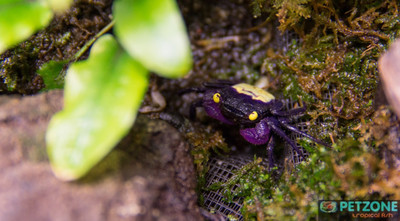The Purple Vampire Crab: A Stunning Creature of the Mangroves
Posted by Max Gandara on on 12th Oct 2023
The Purple Vampire Crab is primarily found in the coastal regions of
Southeast Asia, with a primary distribution in areas like Indonesia and
parts of Thailand. Its natural habitat comprises the intertidal zones of
mangrove forests, where it dwells in burrows and moves between land and
water with the changing tides.
The most distinctive feature of the Purple Vampire Crab is its striking
purple coloration, which sets it apart from most other crab species. It
displays various shades of purple, with some individuals having a more
intense hue than others. The crab's body is relatively small, typically
measuring around 2 to 3 centimeters in width. They have a robust and
rounded carapace with a convex shape, and their legs are relatively
short compared to those of aquatic crabs.
The Purple Vampire Crab is named for its nocturnal behavior and its
penchant for scavenging at night. These crabs are opportunistic
omnivores, feeding on a variety of organic matter, such as decaying
plant material, insects, and smaller invertebrates. They are also known
for their ability to climb mangrove roots and vegetation, making them
adept at foraging for food both above and below the waterline.
These crabs are highly territorial and can be aggressive towards
conspecifics (members of the same species). Male Purple Vampire Crabs,
in particular, can be quite pugnacious when defending their territory,
displaying dominance by raising their claws and engaging in displays of
aggression.
The Purple Vampire Crab exhibits an interesting reproductive strategy.
Mating occurs when the female releases pheromones to attract a male.
After mating, the female carries the fertilized eggs under her abdomen.
She then retreats to her burrow, where she remains until the eggs hatch,
effectively protecting them from potential predators.
Caring for Purple Vampire Crabs in Captivity:
Due to their striking appearance and intriguing behaviors, Purple
Vampire Crabs have become a sought-after species in the aquarium trade.
However, they require specific care to thrive in captivity:
1. Enclosure: Provide a well-ventilated, terrestrial enclosure with a
mixture of land and water. Make sure the crabs have access to both
areas.
2. Temperature and Humidity: Maintain a temperature range of 24-28°C
(75-82°F) and high humidity to mimic their natural mangrove habitat.
3. Diet: Feed them a varied diet, including high-quality crab pellets, small insects, and plant matter.
4. Social Dynamics: Be cautious when keeping multiple crabs in the same enclosure, as they can be territorial and aggressive.
5. Substrate: Use a substrate that retains moisture, such as coconut coir or a mix of sand and coconut coir.
The Purple Vampire Crab, with its alluring purple coloration and
intriguing behaviors, stands as a testament to the captivating
biodiversity of the world's mangrove ecosystems. In both its natural
habitat and captivity, these crabs provide an opportunity to learn more
about the fascinating adaptations that allow them to thrive in an
ever-changing environment. However, responsible care and preservation of
their natural habitats are essential to ensure the continued existence
of this remarkable species.

